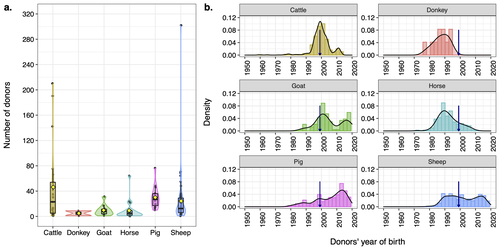


The study by Jacques et al. (2024) addresses a critical concern in the context of genetic diversity erosion in domesticated animal populations. The research uses data from the cryopreserved resources from the French National Cryobank to manage genetic diversity in livestock species. The authors employ a comprehensive methodology to propose novel biodiversity metrics to characterize the status of genetic diversity of cryopreserved collections including cattle, sheep, goat, horse, donkey, and pig livestock species. The findings reveal significant variations of genetic diversity at species and breed levels. Breeds with a large commercial distribution had more donors in the collection than local breeds. The authors propose a practical framework for assessing germplasm collections, providing a valuable tool for planning and managing collections at both national and international levels. The study also highlights the usefulness of the Gini-Simpson and effective donor numbers indices to plan a more efficient sampling, whereas the index of diversity impact can be employed in the selection of the most suitable donors for immediate use, based on pedigree but also using genetic markers.
In resume, this study makes a significant contribution to the field by offering a framework for the assessment of germplasm collections. Its innovative metrics provide insights that could guide strategic decision-making in planning, managing, and utilizing cryopreserved resources. This research is relevant and can benefit conservationists, and population genetics working towards the preservation and sustainable use of genetic resources in livestock species.
Reference
Jacques, A., Duclos, D., Danchin-Burge, C., Mercat, M. J., Tixier-Boichard M., Restoux, G. (2024). Assessing the potential of germplasm collections for the management of genetic diversity: the case of the French National Cryobank. bioRxiv 2023.07.19.549644. ver. 3 peer-reviewed and recommended by Peer Community in Animal Science. https://doi.org/10.1101/2023.07.19.549644
DOI or URL of the preprint: https://doi.org/10.1101/2023.07.19.549644
Version of the preprint: 2
Dears Authors,
We already have the feedback of two independent reviewers. I agree that the manuscript is well-written and presents a valuable methodology for characterizing the genetic diversity of cryopreserved collections in gene banks.
However, before recommending it, the authors must consider the few major comments of both reviewers. After that, I'm confident that the manuscript can be recommended for publication.
Best regards,
Yuliaxis
This study proposes a methodological framework and two novel statistics, a Gini-like index and the index of diversity impact (IDI), to assess the management of genetic diversity in germplasm collections and apply them to the National Cryobank in France. The manuscript is well-written, and the methodology, data and results are clearly explained and detailed.
I congratulate the authors for their nice work, including calculating uncertainty for their novel statistics. Please see below my comments/suggestions.
Major comments
· The abstract mentions that IDI values can also be calculated using genomic data. However, this is never detailed in the manuscript. It’d be great to expand on the authors’ suggestion, outlining how could this be achieved.
· The term “kindship” is used frequently throughout the manuscript but never adequately defined. Readers will benefit from a proper description of this term and a brief explanation of the method(s) behind the PEDIG software to calculate it.
Minor comments
L62 More recent work from FAO, Ajmone-Marsan et. al (2023), is missing here.
L69 Less common breeds -> Non-commercial breeds?
L153 Regression trees are mentioned for the first time without any explanation (this comes later in L170)
Typos/Omissions
L180 "Nb_donors" not defined in the text
L185 Nb_doses not defined in the text
L238, L238 and others Define variable “phi”
References
Ajmone-Marsan, P., Colli, L., Ginja, C, Kantanen J. & Lenstra, J.A., eds. 2023. Genomic characterization of animal genetic resources. FAO Animal Production and Health Guidelines No. 32. Rome, FAO.
The paper is well-written and presents a valuable methodology for characterizing the genetic diversity of cryopreserved collections in gene banks. It employs the French National Cryobank as a case study and introduces new biodiversity metrics, such as the Index of Diversity Impact (IDI), for effective management and assessment. I have just few general comments.
The paper lacks a comprehensive discussion on potential methodological limitations that influence the assessment of factors such as the number of donors per breed and doses per donor. In countries with extensive data recording or efficient communication with farmers, controlling for variables like pedigrees might be more straightforward. Therefore, in my opinion, the study falls short in addressing the quality of pedigrees in the interpretation of genetic diversity metrics. This omission compromises the reliability of the study's findings. In situations where pedigrees are unavailable or unreliable—particularly for local breeds in extensive or challenging conditions—alternative methods such as molecular markers or genomic analyses should be considered
The term "quickly," used to describe the loss of genetic diversity, is vague and needs quantitative clarification. Different species can lose diversity at differing rates, so establishing a time-scale would provide useful context.